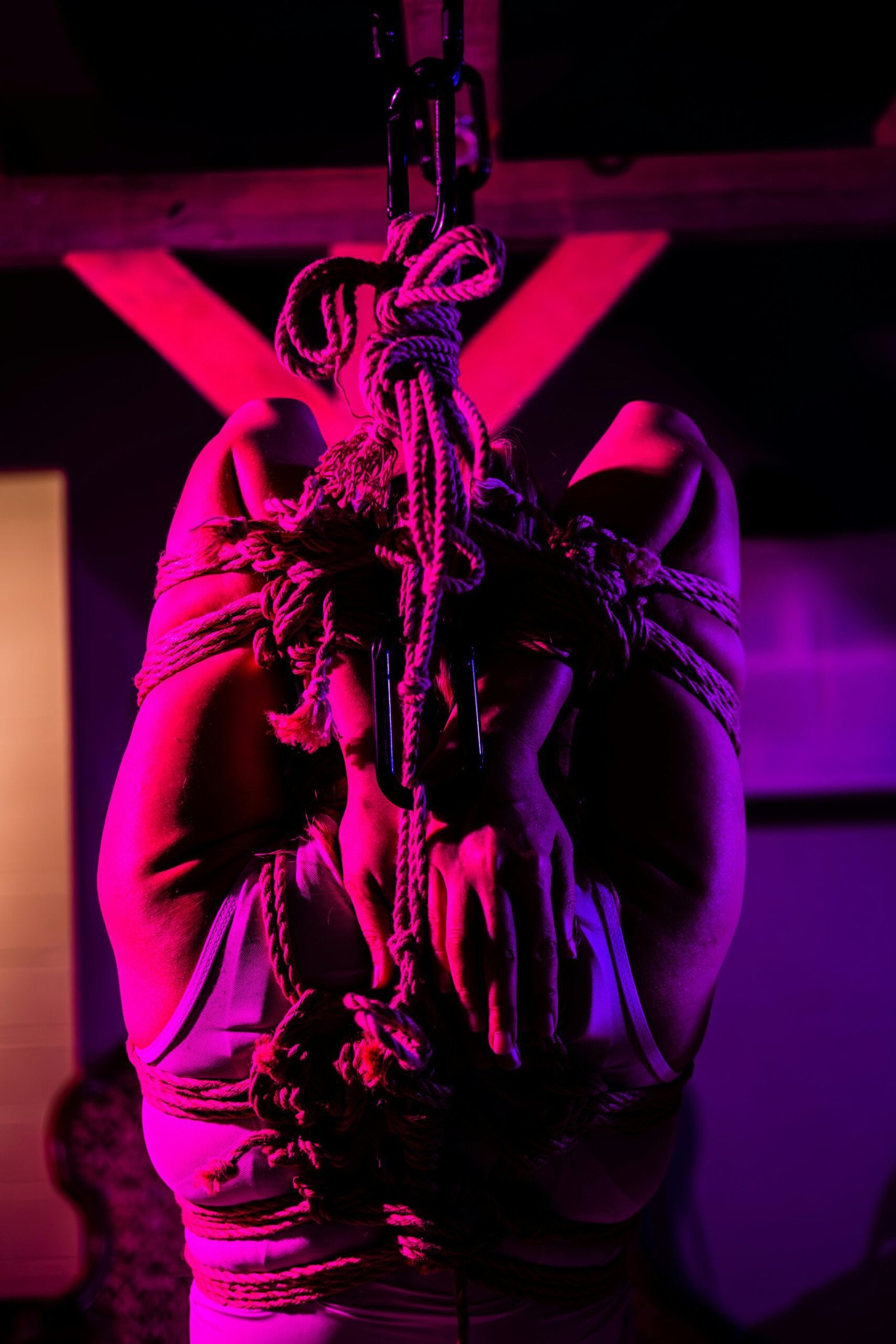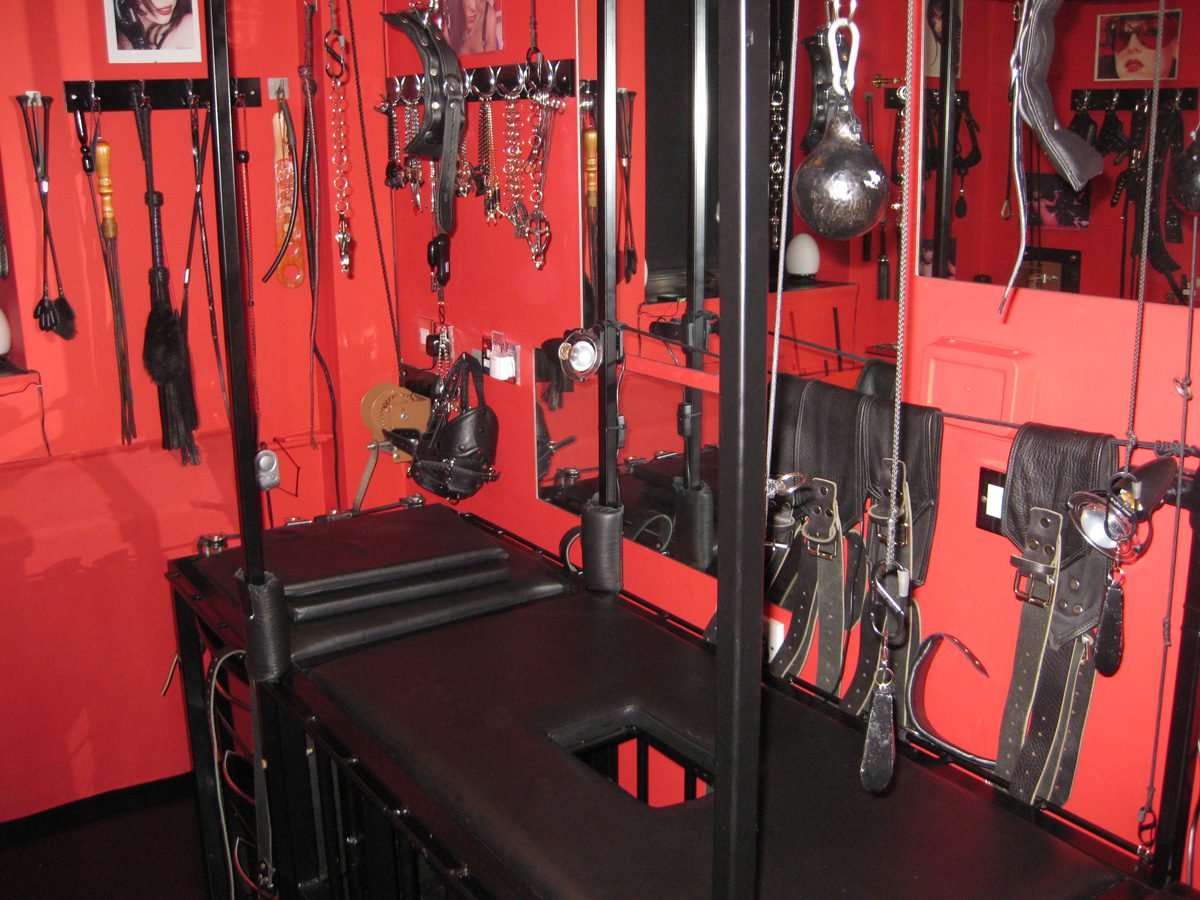
Table of Contents
Introduction to How to Build a Dungeon
BDSM dungeons and sex rooms are specialized environments designed to facilitate consensual BDSM activities. These spaces are crafted with intent, ensuring that participants can explore their desires, fantasies, and boundaries in a safe and controlled setting. A well-constructed BDSM dungeon not only enhances the physical act of BDSM but also amplifies the psychological and emotional experience by creating an atmosphere that is both immersive and stimulating. How to build a dungeon is a question we are often asked by those new to BDSM Femdom. Its not as hard as it first seems.
Individuals may choose to build their own BDSM dungeon or sex room for a variety of reasons. Firstly, a dedicated space allows for heightened privacy and personal comfort. It offers an escape from the everyday, a sanctuary where one can fully delve into their fantasies without the fear of interruption. Additionally, having a devoted space enables the secure storage of specialized equipment and toys, ensuring they are always readily available and properly maintained.
Creating a BDSM dungeon is not merely about acquiring the right equipment; it’s about fostering an atmosphere that enhances the mood and overall experience. This involves thoughtful consideration of the room’s design, lighting, and sound to align with the desired aesthetic and energy. From the color of the walls to the type of furniture chosen, every aspect plays a role in setting the tone for the activities that will take place within.

This guide will take you through the essential steps of how to build a dungeon: A Step-by-Step Guide for Beginners. We will cover the initial planning phase, including selecting the ideal location and determining a suitable budget. Next, we will delve into the core components, such as the essential furniture and equipment, ensuring that safety and functionality are prioritized. We will also explore how to create the right ambiance with tips on lighting, sound, and décor. Finally, we will provide advice on maintaining and updating your space to ensure it continues to meet your needs as you grow and evolve in your BDSM practice.
Building a BDSM dungeon is an exciting and deeply personal project that can significantly enhance your BDSM experiences. By following this guide, you can create a space that is both practical and evocative, tailored to your unique preferences and desires.
Understanding BDSM Dungeon: Definition and Purpose

“how to build a dungeon” is not something you can just get your Dad or your next door neighbor. A BDSM dungeon is a dedicated space designed for consensual activities involving bondage, discipline, dominance, submission, sadism, and masochism. Originating from the spheres of alternative and fetish lifestyles, these environments have evolved over time to become safe havens where individuals and partners can explore their fantasies and power dynamics. Unlike its often misunderstood portrayal in mainstream media, a BDSM dungeon is fundamentally built on mutual respect, trust, and clear boundaries.
Historically, the concept of a BDSM dungeon can be traced back to underground clubs and private gatherings where enthusiasts gathered to practice and share their interests. Over recent decades, the understanding and acceptance of BDSM practices have grown, leading to the creation of more personalized and private spaces for individuals who seek the privacy and freedom to engage in their preferred activities safely.
Common misconceptions about BDSM dungeons include the belief that they are inherently dangerous or that activities conducted within them are non-consensual. However, a well-designed BDSM dungeon emphasizes safety above all else. Basic elements typically found in these spaces can range from padded furniture, restraints, and specialized tools like floggers and paddles to softer touches like ambient lighting, soundproofing, and comfortable seating areas. The primary purpose of these items is to enhance the experience while maintaining the utmost considerations for safety and comfort.
The benefits of having a BDSM dungeon are manifold. Privacy is a significant advantage, allowing individuals to engage in their practices without fear of external judgment or interruption. Convenience is another, providing easy access to necessary equipment in one location. Most importantly, a BDSM dungeon maximizes safety by offering an environment where risks are minimized, and emergency protocols can be established and easily accessed.
Initial Planning: Getting Started with building a Dungeon
Embarking on the creation of a BDSM dungeon requires thoughtful initial planning, ensuring a tailored and gratifying experience for all users. How to build a dungeon doesn’t come with every home maintenance self help guide. Begin by considering your budget. This will significantly influence the scale and quality of items you can procure. Establish a clear financial plan, allocating funds for essential purchases first and allowing some flexibility for desired extras.
Next, evaluate the available space. A dedicated room is often ideal, providing privacy and an immersive environment. However, a section of a larger room can also be transformed effectively with the right planning. Measure your space accurately to determine what equipment and furniture will fit comfortably without overcrowding.
Understanding the specific needs and preferences of those who will use the dungeon is crucial. Engage in open and honest conversations with your partner(s) to identify the activities you will engage in most frequently. This dialogue informs your list of ‘must-have’ and ‘nice-to-have’ items. ‘Must-have’ items might include essential BDSM furniture like a spanking bench or a bondage bed, while ‘nice-to-have’ items could be additional luxury restraints or ambiance-enhancing decor.
It’s essential to consider the impact on others who may share your living environment. Open communication with roommates or family members can prevent misunderstandings and ensure that your privacy, as well as theirs, is respected. Establishing clear boundaries and possibly soundproofing the chosen area can address most concerns.
By addressing these initial planning steps carefully—budget, space, preferences, and communication—you lay a solid foundation for your BDSM dungeon, ensuring a safe and satisfying environment conducive to your explorations and experiences.
Designing Your Dungeon: Setting the Scene
Creating the ideal atmosphere for a BDSM dungeon involves deliberate choices in aesthetics, lighting, and design elements. The environment should be immersive, enhancing the emotional and sensory experience. No how to build a dungeon guide on a womans site should be complete without decor that pleases the female eye! Choosing the right colors is crucial; often, darker hues such as deep reds, blacks, and purples are preferred for their connotations of mystery and intensity. These shades can create a rich, enveloping atmosphere that heightens the senses.
Lighting should be carefully considered to complement the overall design. Dim, adjustable lighting can offer flexibility, allowing for both intense moments and softer interludes. Consider using candles, lanterns, or LED strip lights, which can provide soft, diffuse light or more focused beams as needed. The key is to establish a lighting scheme that enhances the ambiance without overpowering the space.
Decorations and thematic elements can further personalize the dungeon. For a medieval theme, for example, you might incorporate iron fixtures, wooden furniture, and tapestries. If a more modern aesthetic is preferred, sleek metal surfaces and minimalist designs could be suitable. Accessories such as mirrors, artwork, or statues can provide visual interest and stimulate the imagination.
Soundproofing is an essential aspect of a BDSM dungeon. Ensuring privacy and preventing outside noise from intrusion enhances the sense of seclusion and focus. Heavy curtains, acoustic panels, or even carpets can help absorb sound, maintaining the intimacy of the space. It may also be beneficial to choose a secluded room or basement for added insulation from external disturbances.
Ultimately, the dungeon should reflect the unique tastes and preferences of its owner. Whether through specific genres, motifs, or personalized touches, the space should evoke a sense of comfort and excitement. By thoughtfully curating the aesthetics, lighting, and privacy measures, one can create an environment that is as inspiring as it is functional.
Essential Equipment and Gear
Creating a functional and safe BDSM dungeon requires a thoughtful selection of essential equipment and gear. One of the fundamental elements to consider are restraints, which are used to limit movement and enhance the submissive experience. Options include cuffs, rope, and bondage tape, each offering different levels of security and comfort. Leather cuffs, being durable and soft on the skin, are highly recommended for both beginners and advanced practitioners.
Beyond restraints, the inclusion of BDSM-specific furniture is crucial. Items such as St. Andrew’s crosses, spanking benches, and bondage tables form the backbone of any well-equipped dungeon. A St. Andrew’s cross, an X-shaped frame, is used for standing restraints and offers multiple attachment points for securing limbs. Spanking benches provide a comfortable yet secure position for various impact play activities. Bondage tables, often padded for comfort, serve as versatile platforms for restraint and sensory play. Investing in these furniture pieces can significantly elevate the overall experience.
Safety tools are another critical aspect to address. Always have items such as safety shears, first-aid kits, and safe-word protocols readily available. Safety shears are designed to cut through restraints quickly in case of emergency, while first-aid kits are essential for addressing minor injuries that might occur. Establishing a safe-word protocol ensures clear communication between partners, making it easier to identify when boundaries are being crossed.
Understanding where to purchase high-quality BDSM gear is equally important. Specialty stores and online retailers offer a wide range of products tailored for safe and effective use. For those on a budget, DIY options are viable. Basic tools and materials can be transformed into effective bondage equipment with a bit of creativity and craftsmanship. Online tutorials and community forums often provide valuable insights and instructions for creating reliable DIY gear.
By carefully selecting and maintaining the right equipment, you guarantee a safe and fulfilling experience in your BDSM dungeon, whether you’re a beginner or an experienced enthusiast.
Setting Up and Construction, the actual ” how to build a dungeon” part!
Creating a BDSM dungeon requires careful planning and thoughtful execution to ensure a functional and safe space. Central to this process is the arrangement of furniture and equipment in a manner that promotes ease of access while maintaining a safe environment. Begin by selecting an appropriate room where privacy and discretion can be assured. Basements, attics, or soundproofed areas are ideal choices. Once the location is decided, the next step involves planning the layout.
First, consider the placement of primary furniture pieces such as a spanking bench, St. Andrew’s cross, or bondage bed. These items should be strategically positioned to allow enough space for movement and ease of access. Next, focus on installing hooks or mounts. These can be ceiling-mounted hooks for suspension activities or wall-mounted brackets for restraining devices. Ensure that anchors are appropriate for the weight and strain they’ll be subjected to, using heavy-duty materials such as stainless steel or wrought iron to guarantee durability and safety.
When organizing the space, keep functionality at the forefront. Arrange equipment so that it is easily reachable and well-organized, avoiding any clutter or potential hazards. Utilize storage solutions such as shelving units, cabinets, and racks to store smaller items like ropes, paddles, and blindfolds. Labeling storage containers can further aid in efficient organization.
Tools and materials needed for setting up your BDSM dungeon include a tape measure, power drill, heavy-duty screws, and anchors for mounting. High-quality equipment and robust furniture are essential to withstand the rigors of BDSM activities. Additionally, incorporate safety measures such as first aid kits, fire extinguishers, and emergency cut tools for ropes.
Common challenges may involve ensuring the stability and security of mounts and avoiding potential damage to walls or ceilings. Address these issues by consulting with professionals if necessary, and regularly inspect equipment and mounts to maintain safety standards. By following these guidelines, you can construct a BDSM dungeon that is both functional and secure, providing a dedicated space for exploration and play.
A awhile ago (it was months when I first wrote this), Netflix released a saucy new reality show called How to Build a Sex Room. Designer, Melanie Ruth Rose, and quirky general contractor “Mike,” help couples to build the fantasy sex room of their dreams in this eight-episode miniseries. I know it gave me wayyyyyyyyyyyyyyyyyyyyyyyyy to many ideas! Now I want to rebuild everything LOL
Safety Measures: Ensuring a Safe Environment
Safety is a paramount concern when designing and utilizing a BDSM dungeon. The inherent risks associated with BDSM activities make it essential to take comprehensive measures to ensure a safe environment for all participants. Proper equipment use, emergency planning, and regular maintenance checks form the cornerstone of a secure BDSM dungeon.
Proper equipment use is critical. It is imperative to ensure that all the tools and fixtures in the dungeon are safe and fit for use. Ropes, restraints, and suspension points should be regularly inspected for wear and tear. Utilizing only high-quality, purpose-made BDSM gear can further reduce the risks of accidents.
Emergency plans should always be in place. Having a first aid kit readily available and ensuring all participants know its location can make a significant difference in an emergency. Additionally, it is advisable to have a mobile phone or communication device on hand to call for help if needed. Learning basic first aid, including CPR, can be a valuable investment for everyone involved.
Routine maintenance checks are vital for the dungeon’s ongoing safety. This involves inspecting the dungeon space itself for potential hazards such as loose floorboards, faulty lighting, or unstable fixtures. Regular cleaning and sanitation can prevent the spread of infections and maintain a hygienic environment.
Consent is the foundation of any BDSM interaction, and having clear communication channels is essential. Establishing safe words or signals allows participants to communicate their boundaries and ensure that these are respected at all times. Both verbal and non-verbal cues should be understood and agreed upon before the session begins.
Ongoing education and training are crucial to minimizing risks in a BDSM dungeon. Participating in workshops, reading relevant literature, and engaging with the BDSM community can provide valuable insights into best practices and new safety techniques. Staying informed and updated with the latest safety protocols helps to create a secure and respectful environment for everyone involved.
Maintaining and Upkeeping Your Dungeon
Maintaining a BDSM dungeon is both a practical and essential aspect of ensuring a safe and enjoyable experience for all participants. First and foremost, cleanliness is paramount. Establishing a rigorous cleaning regimen is vital; this not only prolongs the life of your equipment but also ensures a hygienic environment. Regularly disinfect surfaces, especially those that come into direct contact with skin, using a solution appropriate for the materials in question. Leather, for instance, requires specific cleaners that preserve its integrity, whereas metal can be treated with standard disinfectants.
In addition to cleanliness, performing regular inspections for wear and tear is critical. Examine all equipment thoroughly—ropes, cuffs, furniture, and any mechanical devices—paying close attention to any signs of deterioration or malfunction. Addressing small issues before they escalate can prevent potential injuries and extend the lifespan of your gear. It’s prudent to have replacement parts or tools on hand for minor repairs. Establish a routine for these inspections, perhaps on a monthly basis, to ensure nothing is overlooked.
Proper storage solutions can also significantly extend the usability of your equipment. Store items like ropes and leather gear in cool, dry places to prevent degradation. Utilize drawers, bins, and hooks to keep everything organized and easily accessible. Labeling storage areas can help maintain organization and quick retrieval of needed items.
Maintaining the physical space of your dungeon is crucial, but equally important is fostering trust and communication among its users. Ensure that everyone who utilizes the space is briefed on the importance of respecting the area and the gear within it. Open dialogue regarding any concerns about equipment safety or cleaning processes should be encouraged and facilitated. A well-maintained dungeon reflects the care and respect of its users towards the practice and each other.








I cant wait till I have my own place to fit out. Good article. Thank you Simon
Oh let me dreams!